AND NEWSPAPERS
For
the time being, I will post in this section only major articles
in
magazines. As the site grows and becomes more complete, I hope to be
able
to include other, less comprehensive articles. There are a number of
articles
about Bix and related topics in current issues of the Past
Times, Joslin's Jazz Journal, and undoubtedly in other jazz
magazines.
I will include some of these articles, and others, in the future.
 The collection of articles, written mostly by people who knew and
played
with Bix, is entitled "Bixology". There are articles by Wayne Rohlf,
Hoagy
Carmichael,
Frank Trumbauer, and Hugues Panassie.
The collection of articles, written mostly by people who knew and
played
with Bix, is entitled "Bixology". There are articles by Wayne Rohlf,
Hoagy
Carmichael,
Frank Trumbauer, and Hugues Panassie.I am indebted to Leslie Johnson, editor of the Mississippi Rag, for providing the list of references quoted above.
Joslins
Jazz Journal. The
Journal has published three stories, written by Bill Saunders,
about
Bix at Lake Forest Academy. The first story was published in the
February
1998 issue and dealt with the location of the Academy, the grounds, and
the dormitory (East House) where Bix roomed while at the Academy. There
was a follow-up in the November 1998 issue of JJJ. It went into detail
about Bix's activities in music and in sports during the year he spent
at the Academy. The third article was published in the February 2000
issue.
It provides exciting news: two hitherto unknown photographs that
include
Bix (in blackface) are included. They are photographs related to the
Bo-Jack
initiation activities. Another interesting image in the article is that
of a dance card form the Academy Football Dance of November 26, 1921.
The
back page of the card has the following writing: "MUSIC BY
SID-BIX-WALLY'S
ORCHESTRA".
I am grateful to Hans Eekhoff
for
alerting me to the existence of the photographs in the February issue
of
JJJ and to Frank Manera for sending me a copy of the article.
Davenport Democrat and Leader: A Short Interview of Bix's Mother. The April 25, 1928 issue of "The DavenportDemocrat and Leader" carried a story about Bix Beiderbecke. It was discovered by Rich Johnson in March 2001. I am grateful to him for his generosity in making a copy and sending it to me. I copy below the entire article.
***************************************************
[1921 photograph of Bix]
"BIX
BEIDERBECKE,
perhaps the finest trumpeter in the country, will now play for you his
own composition 'In a Mist'."
This simple
announcement in the Paul Whiteman orchestra broadcast in the midnight
program
over the national networks from New York Tuesday night electrified the Davenport listeners-in, and most of all a little family
group in the B. H. Beiderbecke home, 1934 Grand avenue. Their son,
Leon,
was that same "finest trumpeter."
electrified the Davenport listeners-in, and most of all a little family
group in the B. H. Beiderbecke home, 1934 Grand avenue. Their son,
Leon,
was that same "finest trumpeter."
But six
months
ago he joined Paul Whiteman's orchestra after repeated requests from
that
famous jazz leader. His reticence was due to the fact that he played by
ear and scarcely knew one note from another. Now he is a soloist and a
composer; this latter with the aid of a fellow musician who wrote the
score
as he played it, "In a Mist" he played on the piano in this featured
broadcast.
"Bix", as he
was known by the gang, and there always was a gang of "fellers" with
him
in his boyhood days, has displayed his jazz tendencies since earliest
youth.
He went to the local schools, went 3 years to Davenport high school and
one year to the Lake Forest academy in Lake Forest, Ill. He was known
as
a jazz artist in every school he attended but beyond that school had
little
appeal and he had no inclination to go on to college.
Music
lessons,
too, were too much like a grind. He took piano lessons for a time from
two local instructors, not more than a score in all. He had wonderful
promise,
his teachers said, but he veered away from the labor of learning. What
was the use of droning "one, two, three, four" when you could rattle
the
latest jazz tune thru a magic sense entirely apart from mathematics? So
ran his youthful reasoning.
He exhibited
the same attitude toward a business career. During the  summers
he assisted his father in his coal office, but for a life work he had
other
plans.
summers
he assisted his father in his coal office, but for a life work he had
other
plans.
For the past
three years he has been cornetist with the Jean Goldkett [sic]
orchestra
of Detroit, and it was in one of the musical tours with that
organization
that Paul Whiteman heard him play. He is now 25 years old.
"We can
always
tell when Bix's horn comes in," says his mother."We know everytime Paul
Whiteman's orchestra is on the air and Leon knows we'll be listening
in.
The air is carried out by the other cornetist but the sudden perky
blare
and the unexpected trills-those are the jazz parts and they are Leon's."
***************************************************
I think this article, in
particular, the statement by Bix's mother, is of great significance.
There
has been, in the Bix literature, the view that Bix did not get along
with
his family. This article shows that the Beiderbecke family (note that
Bix's
mother talks about "we") followed Bix's career closely ("We know
everytime
Paul Whiteman's orchestra is on the air and Leon knows we'll be
listening
in.") and had a good appreciation of exactly how Bix was playing
with the band. They clearly understood Bix's unique musical
contribution
to the Whiteman orchestra: "the sudden perky blare and the unexpected
trills".
That is what fellow musicians said later on. I remind you of George
Johnson's
statement: "Bix was a fountain of ideas that were spontaneous, as
unexpected
to himself as they were to us." Mrs. Beiderbecke displays an
astonishing
insight and a deep understanding of Bix's unique musicianship.
I thank Rich Johnson for sending me a copy of the ad in the Daily Times.
The
Daily Times: Radio Station Tribute to Bix
The August 8, 1931 issue of the Davenport newspaper
carried
the following column.
"Station WOC Pays Tribute to Memory of Bix
Beiderbecke.
Stations WOC and WHO paid a brief tribute to Leon Bix Beiderbecke, who
died Thursday night in New York City, during the broadcasting of the
Valley
dance program this noon, when Bert Sloan, pianist, played one of his
compositions,
'In A Mist,' and the announcer read the following statement.
'We are saddened at the untimely death of Leon "Bix"
Beiderbecke, Davenport boy who made himself famous as one of the
leading
trumpet players of the Unidted States.
Bix passed away last Thursday at 9:30 p.m. in New
York
City after a brief illness of pneumonia. Recognized as a musical genius
while still in his home town, Leon Beiderbecke went to the cities where
for three years he acted as trumpet soloist, playing for "The King of
Jazz,"
Paul Whiteman, who recognized Bix's ability and termed him "the finest
trumpeter in the country." He was connected for about the same length
of
time with Gene [sic] Goldkette's orchestra in Detroit, during which he
did considerable recording and broadcasting.
It was quite natural that anyone so talented should
turn
to the work of composing music, and among the many numbers which he
brought
out, one stands forth as a fine example of modern rhythm.
In memory of Leon "Bix" Beiderbecke, Bert Sloan will
play as a piano solo this young genius'outstanding composition, 'In A
Mist.'"
I thank Rich Johnson for sending me a copy of the article.
The
All-America Swing Band Selected by Paul Whiteman
The September 10, 1938 of Collier's includes an
article
by Paul Whiteman where he discusses his choice of musicians for the
"All-America
Swing Band." Whiteman writes, "I am going to pick the All-America
supercolossal
swing band of our time... One more thing before we go into our dance: A
good swing man is a good musician. I have nothing but contempt for the
so-called highbrow music lovers who look at swing wih contempt... Every
man I'm picking on my All-America team, except one, is a fine reader of
music... I am not only presenting the greatest swing band in the
country;
I am presenting a group of the best musicians in the country. I said
that
one of my selections [Art Tatum who was blind] can't read
music.
I'll explain that when I come to it."
"Here they are folks."
Guitar
Carl Kress **
Alto
Sax
Jimmy Dorsey **
Alto
Sax
Benny Carter
Tenor
Sax
Ed Miller **
C melody Sax Frankie
Trumbauer
**
Trumpet
Manny Klein
Trumpet
Charlie Teagarden **
Trumpet
Roy Elridge
Trumpet
Louis Armstrong
Trombone
Tommy Dorsey **
Trombone
Jackson Teagarden **
Trombone
Jack Jenney
Piano
Art Tatum
Piano
Bob Zurke
Accordion
Tito
Violin
Joe Venuti **
Violin
Al Duffy
Violin
Matty Malneck **
Violin
Eddie South
Bass Violin
Bobby Haggart
Clarinet
Benny Goodman **
Clarinet
Artie Shaw **
Vibraharp
Adrian Rollini **
Drums
Gene Krupa **
Drums
Ray Bauduc **
The stars following the name identify the
musicians that
recorded and/or played with Bix (slightly more than half of the
musicians
chosen by Whiteman). Of course, Bix (also Eddie Lang) is not in the
list;
only living musicians were included.
Whiteman commented on every one of the choices he
made.
I copy here a few selected ones directly relevant to the subject of
Bixology..
"Frankie Trumbauer is going to play the C melody sax on my team and you know that there is no one in the country within a mile of Frankie. Did you ever hear him play "Singin' the Blues" as a solo? Man, you ain't heard nothing if you ain't heard Frankie give that one out."
"Now we come to the trumpet, and when you
mention the
word trumpet you think of Bix Beiderbecke. Bix was the "Beau Geste" of
the trumpet; he was supreme at his style. I have seen swing fans shake
their heads in admirationafter hearing a trumpet play a chorus and have
heard them say, "That guy is so great that he never plays a chorus
twice
the same way." That's another fallacy about swing I would like to nail.
Any time Bix played a chorus it was almost a complete composition in
itself.
And when he got it right he kept it in unless he could improve it.
Once I heard Bix shake his head sadly after
hearing
a trumpet player and say, "He plays so many notes and they mean so
little."
Bix was a note miser. He never played an
unnecessary
note or an accidental one. The sheer beauty of some of his passages
rings
in my ear as I write this. It's too bad that Bix had to go."
"Manny Klein is my first selection on the trumpet. I will say without qualification that Manny Klein is the greatest all-around trumpet player alive today. That takes in a lot of territory but not too much for Manny to cover."
"I know that Rex Stewart of Duke Ellington's band is terrific and I know some think Bunny Berigan could chase them all out of town, but right now I come to picking a trumpet player about whom there will be no argument. If anyone objects to my putting Louis Armstrong on our All-America band, I will swing a viola around his neck. Louis started the present style of swinging a trumpet and he has popularized it and thousands are now copying Ol' Satchmo' Armssstrong. If I ever took an All-America swing band to Europe without Armstrong, those British swing fans would tosss me right out. Satchmo' can do a great many things. You haven't lived until you have heard him sing "Jonah in the Belly of the Whale;" and you haven't heard real swing if you haven't heard Armstrong on hat trumpet. Now if Armstrong couldn't play a note, I'd still want him around. He is the greatest ad lib. entertainer I know, a cheerful, happy-go-lucky son of a gun."
Some rather provocative comments, in particular Whiteman's assertion about the "myth" of Bix never playing a chorus the same way twice.
I am grateful to an anonymous Bixophile and to Rich Johnson for calling my attention to this article.4/11/03.
Life
Magazine Article (uploaded
April 23, 2003)
The August 8, 1938 issue of
Life
has an 11-page article about "swing." As one might anticipate for an
article
in Life, there are more photographs than text. The article consists of
the following stories.
1. "Swing, the Hottest
and best
kind of Jazz Reaches Its Golden Age." A general introduction with
photos
of Tommy Dorsey, Bob Crosby, Arty (sic) Shaw, Red Norvo and the Benny
Goodman
band (which at the time included, among others, Dave Tough, Harry
James, Ziggy Elman, Harry Goodman, Jess Stacy, Bud Freeman, and Arthur
Rollini. Here are some excerpts from the introduction..
The most articulate hot
musician
cannot give a strict definition of Swing. But all definitions agree
that
Swing is based on: 1) a driving and fluid unmechanical rhythm over
which
2) soloists improvise as they play. Whatever the definition, everyone
admits
that of all jazz Swing is musically the most vital and interesting.
Today,
it is enjoying its golden era not only popularly but artistically.
Swing's first age of glory
began
a dozen years ago. Spreading North with Negroes from New Orleans after
the war, its influence focused in Chicago in 1926 around Bix
Beiderbecke.
It died in 1931, revived in 1934 with the success of Benny Goodman and
the visitation of the jitterbugs.
2. "Swing's Black
Royalty." The
importance of "King" Oliver, "Prince"Armstrong, "Duke" Ellington and
"Count"
Basie in jazz. Includes photos of the bands and of Louis Armstrong.
Here
is the complete text.
Sometime after 1900, Swing
was
born in New Orleans where even funeral bands, having played
respectfully
on the way to the cemetary, broke into jazz on the way home. In
1914,
the Original Dixieland Jazz Band (white) brought jazz out of its
birthplace.
Modern Swing came out with two trumpeters, "King" Oliver and "Prince"
Armstrong
who, like the most royal of Swing's personages, were Negroes.
The late Joe "King" Oliver
took
the rough, street corner jazz of New Orleans, cleaned it up and gave it
form. "Prince" Louis ("Satchelmouth") Armstrong, who had learned to
play
trumpet in a waif's home, learned to play Swing in Oliver's band,
perfected
his style under Fletcher Henderson. Blessed with unbelievable technique
and a rich imagination, Armstrong became the greatest of all Swing
musicians.
Quieter, more studious than
the rampant Armstrong is Edward Kennedy "Duke" Ellington. Only a fair
pianist
but an extraordinary leader-composer-arrnager, Ellingotn has taught his
band to play the subtlest and most varied kind of jazz. Bill "Count"
basie,
a top-notch pianist, has written a major Swing classsic, "One O'Clock
Jump."
3. A Young Man with a Hot
Horn
Became Hero of Fact and Fiction. The only story about a single
musician,
accompanied with photos of Bix as child, at Lake Forest, with the
Rhythm
Jugglers, with the Wolverines and with the Paul Whitmean Orchestra.
Here
is the complete text.
In 1922, Louis Armstrong,
years
ahead of his time in Swing, was playing his colossal solos with King
Oliver
in Chicago. A promising 19-year-old white trumpeter named "Bix"
Beiderbecke
heard him and realized immediately that Armstrong's music was true hot
style, that by comparison his own playing was faltering and "corny"
(i.e.stale
and outdated). Bix Beiderbekce was too fine a musician to be simply an
imitator. But he boldly decided to absorb Negro style which white
musicians
then scorned to play. The decision was momentous. It made Bix the
greatest
of white trumpeters (he actualy played cornet) and the most important
of
all white jaz influences. It also brought him early death and
posthumous
fame. Last May, "Young Man With A Horn," a novel by Dorothy Baker based
on Bix's life, was published. A good book, it is now a best-seller.
Leon Bismarck [sic]
Beiderbecke
was born to a stid merchant of Davenport, Iowa in 1903. When he was 3
and
still wearing bangs and dresses he could play one-finger pieces on the
piano. Later he learned to play the cornet by listening to phonograph
records.
Shipped off to Lake Forest Academy near Chicago, the city which was
fast
becoming the country's Swing capital, he stayed in school only one
year,
left to start his jazz career, got jobs in small bands. After 1923, his
style suddenly became mature. Around here gathered dozens of hot
players
who have since become famous -Teagarden, Russell, Dorsey, Freeman,
Trumbauer.,
etc. All were profoundly influence and inspired by Bix. In 1927, Bix
reached
the top. Paul Whiteman took him on as first trumpet.
When musicians talk about
Bix's
playing, they gasp for adjectives. He had tremendous drive and lift.
His
tone was ravishing, his taste sure, his improvisations amazingly rich.
When musicians talk about Bix as a person, they recall him as a dour,
reticent
man, with a small face that went tense and agonized when he
played
as if he were trying to blow himself into his horn. His only interest
was
music. After quitting work in the early morning, he would round up
other
muscians, go off on long, exhausting, drunken "jam" sessions. He led
the
irregular, dissipated life that swing players have always led.
Bix always felt frustrated.
His music never satisfied him. He always wanted to do things that were
beyond the capacity of either his instrument or his music. he drove
himself
too hard. In 1931, his worn, unhappy body broke down. Bix caught a
summer
cold, quickly succumbed. He was only 27 when he died.
I will comment on this piece at
a later time.
4. Jitterbugs Are Poison
and
Bread & Butter. An account and photographs of jitterbugs.
There
are several mentions of Bix in the text.
Bix Beiderbecke, an earnest
artist, would sadly turn over in his grave if he knew that the art for
which he died had been taken over by the jitterbugs. ... To the hot
musicians,
jitterbugs are plain poison. But they must be humored because they have
brought prosperity to Swing. In 1931, with the depression, the death of
Beiderbecke and the rise of "sweet bands", the interest in Swing
grew faint. ... The hot musician is further annoyed when jitterbugs
burst
into impolite applause after a soloist has finished his chorus.
The last sentence strikes a
chord:
it is one of my pet peeves. Artie Shaw, in a recent interview, also
complained
about the habit of jazz (swing in the article) aficionado [often
misspelled
with two fs] to applaud after a soloist completes his chorus.
5. Hot Players Make 12-in
Records. A
short piece about small combos making hot records. Photos of Bud
Freeman,
Jack Teagarden, Eddie Condon, Pee Wee Russell and Buddy Hackett.
Here are some excerpts.
The most exciting swing
performances
have been given by groups of pick-up musicians who met in a jam session
or recording studio for the simple delight of playing as they pleased.
Bix Beiderbecke always dreamed of getting together a great pick-up
band,
making twelve-inch records -long enough to give soloists chance to
round
up thier work. For the frustrated Bix, the dream never came true. But a
short while ago in a Manhattan recording studio, the kind of band Bix
longed
for came together to make the twelve-inch records he wanted to make.
They
were from five diferent bands. All but two had played with Bix. Two of
them, Russell and Condon, appear in the tattered sanpshot on page 54. [The
photograph is on p. 215 of "Bix: The Leon Beiderbecke Story" by Philip
and Linda Evans] Mostly they recorded never-written song, whose
general
outlines were sketched on the spot. Like most good Swing, the music was
literally composed by the player as he played. Released under the
Commodore
label, the records will probably become collectors' s items.
I believe the recording session discussed above is
from
April 30, 1938 where Embraceable You, Meet Me Tonight, Diane and
Serenade
to A Shylock were recorded. The first and last titles were issued in a
12-inch Commodore 1501 as Jam Session at Commodore No. Two. The band
consisted
of Bobby Hackett, Jack Teagarden, Pee Wee Russell, Bud Freeman, Jess
Stacy,
Eddie Condon, Artie Shapiro and George Wettling.
5. Here Are 30 Good Hot Records. A
compilation
of 30 hot records, in Life's opinion. Accompanied wih photos of B.
Berrigan
[sic], E. Fitzgerald, F. Henderson, T. Wilson, J. Marsala, M. Bailey,
S.
Smith, C. Boswell, F. Waller, G. Krupa, M. Sullivan and Slim and Slam.
Here is the text.
LIFE has compiled, from considered opinions, a list
of
good swing records. Printed below they form the nucleus of a good
collection
for those who would like to know more about hot music. The list does
not
include hard-to-get collectors items. All these disks can be bought at
stores which keep a fairly compelte hot stock. Included are some items
of special interest like the Beiderbecke piano solo (Bix was alnmost as
good on the piano as on the horn) and the freak swing success, "Flat
Foot
Flugie."
Albert Ammons, piano, Boogie Woogie Stomp.
Louis Armstrong, trumpet, West End Blues.
Mildred Bailey, vocalist, Long About Midnight.
Bix Beiderbecke, cornet, Riverboat Shuffle.
Bix Beiderbecke, piano, In A Mist.
Bunny Berrigan [sic], cornet, I Can't get Started.
Connie Bowsell, vocal, Bob White.
Eddy [sic] Condon's Windy City Seven, Carnegie
Drag.
Bob Crosby's Band, South Rampart Street Parade.
Tommy Dorsey, trombone, Stardust.
Duke Elington's Band, Clarinet Lament.
Ella Fitzgerald, vocal (Chick Webb's Band), A
Tisket,
A Tasket.
Benny Goodman, clarinet, Don't Be That Way.
Benny Goodman Quartet, Moonglow.
Fletcher Henderson's Band, Money Blues.
Gene Krupa, drums, Blues of Israel.
Meade Lux Lewis, piano, Yancy Special.
Joe Marsala, clarinet, Hot String Beans.
Red Norvo, xylophone, Blues in E Flat.
King Oliver, trumpet, Dipper Mouth Blues.
Arrtie Shaw, clarinet, Nightmare.
Bessie Smith, vocal, Young Woman's Blues.
Stuff Smith, violin, You'se A Viper.
Joe Sullivan, piano, Honeysuckle Rose.
Jack Teagarden, trombone, Diane.
Fats Waller, piano, Dinah.
Teddy Wilson, piano, Body and Soul.
Mary Lou Williams, piano, Overhand.
Maxine Sullivan, vocal, Overhand.
Slim and Slam, vocal and double bass, Flat Foot
Flugie.
An odd selection. I note that only Bix and
Benny
Goodman have two selections each. No sselections from four of my
favorite
jazz musicians of all times, Miff Mole, Joe Venuti, Eddie Lang and
Adrian
Rollini.
Credit for the photographs of Bix Beiderbecke is given to Bismarck [sic] H. Beiderbecke, Lake Forest Academy, Downbeat, Scholl (probably Warrren) and M. mesirov (known later as Mezz Mezzrow).
I am indebted to Mike Heckman, Rich Johnson and an anonymous Bixophile for calling my attention to this article.
Mississippi
Rag Article (uploaded June 3, 2003)
The June 2003 issue of the
Mississippi
Rag carries a four- page article "Copying Bix: Cornet Solos From Bix
Beiderbecke's
First Three Recording Sessions" by Albert Haim. The article discusses
in
depth the fact that Bix's solos in the Wolverines recordings of "Jazz
Me
Blues" "Copenhagen" and "Tiger Rag" were copied by several
cornetists/trumpeters
soon after the recordings were issued. The author provides a hypothesis
to explain how Bix's solo in Tiger Rag was copied in recordings from
1925-1927
in spite of the fact that the commercial records of Tiger Rag were not
issued until 1936. Images of the record labels and of the Wolverine
Orchestra
are included. The article is documented with citations and references.
Articles
in jazzit in Celebration of Bix 100 (uploaded
June 11, 2003)
The Italian jazz magazine "jazzit"
is published bimonthly. The March/April 2003 issue (Year V, Number 15)
carries two articles in tribute to Bix's 100th birthday. The articles
are
preceded by an introduction written by Vincenzo Martorella, the
editorial
director of the magazine.
1. Davenport Blues. A translation by
Vincenzo
Martorella of the pertinent section in the article by Randy Sandke "Bix
Beiderbecke: from a Musician's Perspective," Annual Review of Jazz
Studies,
Vo. 9, 1997-1998, pp. 165-260.
2. In A Mist: A Voyage in the Fogs of the
Myth.
A translation by Vincenzo Martorella of the pertinent section of the
Bixography
website.
In addition there are announcements of some of the
celebrations
of Bix 100 (Centennary Cruise, Concert at the Blue Lantern, JVC jazz
Festival,
Ascona Festival and Bix Beiderbecke Memorial Jazz Festival) and an
interview
of Randy Sandke.
Bix
in the Dec 9, 1927 Issue of the Cleveland Press (uploaded
May 19, 2004)
Paul
Whiteman
and His Orchestra had an engagement in the Allen Theater, Cleveland,
Ohio
from December 4 to December 11, 1927. The Cleveland Press had an
article
about Whiteman and his band in the December 9, 1927 issue. A copy of
the
page in the paper is reproduced in page 308 of "Bix: The Leon Bix
Beiderbecke
Story" by Philip R. and Linda K. Evans. The image is poor and it is
hard
to read the fine print. Through the courtesy of Elizabeth Beiderbecke
Hart,
we now have an opportunity to examine carefully the article. Liz had a
high resolution scan of the article made and transferred to a CD. When
Bix sent the page of the Cleveland Press to his parents, he wrote
two remarks on the page. On top of the page, Bix wrote, "They got me
sketched
good looking & Tram hideous, how about the moustache?" Bix was
referring
to sketches of Bix and Tram in the issue. Bix's sketch is in the same
page
as the article. Tram's sketch is in another page. Neither Liz nor I
have
a copy of Tram's sketch. I am trying to get a copy of Tram's sketch.
Bix's
second remark comes next to a paragraphy marked by Bix. The paragraph
reads,
"To our way of thinking, no child should be started in life without
being
brought up on this kind of music." Bix wrote, "Get a load of this". To
see the scan of the page, go to http://bixbeiderbecke.com/clevelandpressbix.jpg
The image is 1MB in size. Be patient when downloading.
I am grateful to Liz for kindly sending me the
CD with the scan.
Jazz
Information, The Weekly Magazine (uploaded
Oct 24, 2003)
The Vol. I,
No. 15 December 22, 1939 issue of the magazine published the followigt
item.
"HOT RECORD SOCIETY ISSUES ALBUM OF WOLVERINE RECORDS WITH BIX
Five rare Beiderbeckes, repressed from Gennett originals, will be released this week by the Hot Record Society in an album titled: "Young Man With A Horn; Bix and the Wolverines".
Two sides,"Davenport Blues" and Toddlin' Blues", were made by Bix and his Rhythm Jugglers, featuring Tommy Dorsey, Paul Mertz, Don Murray, Howdy Quickwell and Tom Gargano.
The other eight sides were made by the Wolverines Orchestra, the band in which Bix began his career in the early twenties. The titles include "Fidgety Feet", "Jazz Me Blues", "Oh Baby", "Tiger Rag", "Sensation", "Tia Juana", "Big Boy", and "Royal Garden Blues".
With the new reissues, all of the records Bix made with the Wolverines some fifteen years ago are again available, with the exception of two sides. "Riverboat Shuffle" and "Lazy Daddy" had been previously issued by the H.R.S., and "Copenhagen" is available on U.H.C.A.
A booklet on the records, prepared by Charles Edward Smith, will be released with the album."
The album was reviewed in Vol. I, No. 19, January 26, 1940. here is the review.
NEW RECORDS
YOUNG MAN WITH A HORN: BIXBEIDERBECKE and THE WOLVERINES (Hot Record Society Album No. 2). By the Wolverines: Fidgety Feet (HRS 22); Sensation (HRS 23); Big Boy -- Tiger Rag (HRS 24); Jazz Me Blues -- Oh Baby (HRS 25); Tia Juana -- Royal Garden Blues (HRS 26). By Bix and his Rhythm Jugglers; Davenport Blues (HRS 22); Toddlin' Blues (HRS 23). Personnels listed on labels.
For its second album of reissues the Hot Record Society has selected ten sides by Bix Beiderbecke (eight with the Wolverine Orchestra, two of Bix's Rhythm Jugglers). The masters from which the reissues have been pressed were dubbed, from the Gennett originals, several years ago, for English Brunswick. And, to mention the least important point first, the dubbings are technically uneven. Some are good; on others the reproduction is foggy, and on "Royal Garden Blues" the dubbing needle actually skipped a groove. Comparison of the current prices of Gennetts, however, with the price at which these reissues have been made available, places these facts in their proper perspective.
And these recordings,of course, are invaluable to the student of Bix. They show a less mature musician than Bix's later discs true; but, on the other hand, they are the only ones which show the young man with a horn playing with a permanent band of authentically jazz structure. There are always the Whitemans and Goldkettes and Carmichaels in which Bix took a solo, or a break; there are Frank Trumbauer's rather half-hearted pickup waxings, and Bix's own records with his own pickup band. But only these records of the Wolverines show Bix as a member of a small jazz band, following the jazz tradition as it had been expressed by the Dixieland Band, the New Orleans Rhythm Kings and King Oliver's Creole Band.
No one, we think, has considered the Wolverines as a great band. It was a young band, short-lived, and never reached its maturity. But for what it was, it was good; following the best models, playing the best tunes, and always following its best musician, Beiderbecke.
So there's no listening to this album merely for Bix's solo work. There are solos, to be sure; an extraordinarily melodic chorus on the "Royal Garden Blues", a restrained solo in "Jazz Me Blues" excited solos in "Oh Baby" and "Tiger Rag", and so forth. There are other solos: some acceptable low-register clarinet work by Jimmy Hartwell, a few poor tenor solos of George Johnson's, even one hardly note-worthy piano solo by Bix. But most of the records are the Wolverines' ensemble; and it's for the ensemble, and Bix's part in it, that they should be heard.
Not that the Wolverines' ensemble was by any means perfect. On some of these sides, in fact, it's downright amateurish. On others, though the kids got together behind Bix and really played with drive and conviction. The best sides, at a rapid recount, are "Oh Baby", which has a pretty excited jump and the three sides which, as Charles Edward Smith remarks in his leaflet with the album, show most clearly the influences of the Wolverines: "Royal Garden Blues", for King Oliver, "Sensation" and "Fidgety Feet" for the Dixieland Jazz Band, "Tiger Rag", "Jazz Me Blues" and Big Boy" are also acceptable; only "Tia Juana" is really bad.
A special word should be said for "Davenport Blues" and "Toddlin' Blues", which were recorded by Bix and a pick-up band including Tommy Dorsey and Don Murray, shortly after Bix had joined Jean Goldkette's orchestra. The men were better musicians than the Wolverines, though doubtless less used to playing together; and the results might well have compared to Bix's best work -- except that, as Charles Edward Smith puts it, the boys got into the bottle before they got into the wax. The product was two pathetically disorganized sides, on which nevertheless ("Toddlin"' especially) Bix and Murray were feeling the music.
These few remarks,
evidently, do
not pretend to the definitive word either on Bix Beiderbecke as a
cornetist,
or on the Wolverines as an orchestra. Those who are already familiar
with
the Gennetts need no review; while those who aren't, had better listen
to this album pretty carefully. "
The
Wolverine Orchestra in Variety (uploaded
December 8, 2003)
The Wolverine Orchestra played in
the Cinderella Ballroom, 1600 Broadway, New York City from September
12,
1924 to the end of December 1924. On December 26, 1924 they were
replaced by the Original Dixieland Jazz Band. Bix did not last for the
entire engagement. He left the Wolverines on October 11, 1924 as he had
accepted a job with the Jean Goldkette orchestra in Detroit.
The following are news items, ads
and reviews related to the Cinderella Ballroom and the Wolverines
published
in Variety during September and October 1924.
Wednesday, September 10, 1924.
BALLROOMS ARE OPENiNG UP; NOVELTIES
Cinderella Starts Friday - Intercity Dance Contest
The Cinderella Ballroom, Boadway and 48th Street, New
York, opens Friday (Sept. 13) with Willie Creager and His Ambassadors
(Louis
Katzman, business manager) as the featured attraction. The Ambassadors
are Vocalion disk artists. The Wolverines, a new "hot" combination from
Chicago, will be the alternating orchestra.
The Cinderella, under the direction of the Joseph
Brothers
and Robert Blum, is planning a series of novel stunts this fall such as
an intercity dancing contest in conjunction with the Paradise, Newark,
which they took over from Ray Miller, and Danceland,Philadelphia,
actively
managed by Jack Fiegl. The Cotton Picker's Orchestra at Danceland will
be brought in to the Cinderlla and the Ambassadors sent to Quakertown
as
part of the stunt.
The cabaret night feature successfully tried last
season
will be resumed this fall. The Joseph's contention anent the
introduction
of the entire revues from the various cabarets and cafes is that it
builds
business for the restaurants in reciprocation for the courtesy for the
reason that the regular sstepping out crowd that patronizes the dance
hall
on week days is attracted to the cafes on week ends. The dance halls in
turn draw their Saturday and Sunday business from the "cake eaters,"
who
otherwise stay at home.
The Roseland opens Sept. 16 with Vincent Lopez, Jan
Garber
and Herb Wiedoft's orchestras to augment the Sam Lanin, Phil Romano and
Fletcher Hendrson's combinations.
Remarks. Note that Willie Creager's
Ambassadors
are the featured attraction, the Wolverines being the "alternating"
orchestra.
I am not quite sure I understand the economic advantages of the
"cabaret
night feature." According to Brian Rust ("Jazz Records"), "Willie
Creager
was the leader and drummer of the Ambassaddors, and rumor persists that
his band recorded with Bix Beiderbecke when both were playing in the
Cinderella
Ballroom, New York, in the automn of 1924." With a detailed Bix
chronology
available now, the only sides that could possibly have Bix in them are
those recorded on October 2, 1924. Three sides were waxed,. "My Best
Girl"
and "Me and the Boy Friend" were rejected. "All Alone" was issued as
Gennett
5581. I have not heard these recordings.
Wednesday, September 24, 1924.
BAND AND ORCHESTRAS REVIEWS
THE WOLVERINES (7)
This "hot" septet hails from around Chicago, last
playing
a Gary, Ind., pavilion. It was "discovered" by the Josephs of the
Cinderella
ballroom management, who tout this combination highly.
As a torrid unit it need doff the mythical chapeau to
no one. Their sense of rhythm and tempo is ultra for this type of dance
music, and their unquestionable favor with the dance fans speaks or
itself.
Leon Beiderbecke is a "hot" trumpet; Dick Voynow
plays
piano; Jim Hartwell, clarinetist, highly effective; ditto the bass
Wilford
Leibrook; Vic Moore is at the drums and George Johnson, sax.
The band has struck favor from the sart. Out West
they
recorded for the Gennett disks, but although less than a week on
Broadway,
they have "dates" with a numer of minor companies, with the Brusnwick
also
interested.
Abel [Green]
Remarks. So much for the myth that Bix Beiderbecke's name was found only twice in newspapers during his lifetime. Note that Bix is referred to as "Leon Beiderbecke" and that his name is mentioned first in the review. Note that "hot" is used twice, but jazz not even once.
Wednesday, October 1, 1924.
OXLEY AT CINDERELLA
Harold Oxley and his Orchestra of 11 pieces open at
the
Cinderella Ballroom, New York, Oct. 4, succeeding Willie Creager's
Ambassadors.
Oxley's band is a Paul Specht unit.
Articles About Bix in 1927-28 Issues of the Melody Maker (uploaded on January 14, 2004)
Beginning in April 1927 and continuing until
September
1928, the British magazine "Melody Maker" published one article and
several
record reviews about Bix Beiderbecke.
I am indebted to Nick Dellow for kindly scanning theses wonderful -and revealing- pages from the Music Maker and for his persmission to upload the scans.
***********************************************
SENIOR CLASS DANCE IS WELL
ATTENDED
BY STUDENTS AND GUESTS
Bix Beidebecke [sic] and Dorsey Bros. Furnish Excellent Music for Gala College Affair
One of the
most
successful class dances at Amherst in recent years took place Saturday
afternoon and evening, when the annual Senior Hop was held on College
Hall.
The historic building was decorated in green and white while the
orchestra
was placed on the stage in front of a background of silver, red, yellow
and white streamers. The building was made even more comfortable by the
many chairs and davenports which were a loan from the fraternities. The
dance was attended by approximately 135 couples and 85 stags.
The music was
furnished by two bands, one led by Bix Beiderbecke who alternated with
the Dorsey brothers orchestra under the supervision of Tom Dorsey. The
smaller of the two, Beiderbecke's, is considered one of the best five
piece
outfits in the country. The dance commenced at four o'clock on the
arrival
of the Smith and Mount Holyoke girls and continued until 6 P.M. when
supper
was served at the Lord Jeffery Inn. Dancing was resumed at 7:30 P.M.
and
continued until middnight with a brief intermission at 10:30 P.M. when
the Smith and Mount Holyoke girls departed. The exceptionally large
number
of out of town girls present kept the dance going until twelve.
*********************************************************************
In their
biography
of Bix, "Bix: The Leon Beiderbecke Story," Philip and Linda Evans
report,
"March 14, 1931 (Sat)- Dorsey
Brothers
Orchestra played Senior Hop in College Hall at Amherst College in
Amherst,
Massachusetts. Date booked by Art Michaud.
Personnel: Bix (c); Bunny
Berigan,
Bill Moore (t); Tommy Dorsey, Glenn Miller (tb); Jimmy Dorsey, three
others
(rds); Arthur Schutt(p); Carl Kress(g); Johnny Morris(d); unknown sb.
College
newspaper; "Bix's grop was considered one og the best five-piece outfit
in the country." The five pieces would be Bix, Tommy, Jimmy, Arthur and
Johnny."
In a 1969 interview, Johnny Morrris told Philip Evans, "Bix was very moody and despondent .... not anxious to play, but out of the big band we formed a small jazz group and finally succeeded in getting Bix to "jam" with us."
The Amherst Student article
was
made available through the Courtesy of Amherst College Archives &
Special
Collections at http://www.amherst.edu/library/archives
I am grateful to Peter Nelson for his help with the article.
Red
Nichols on Bix in Down Beat
Here is a complete transcript of
an article that appeared in the August 1937 issue of Down Beat.
************************
"Musicians Killed Bix
Beiderbecke!"
"Bix Died Of A Broken Heart,
Says Famous Leader of Five Pennies"
by Carl Cons
Between sets at the College Inn,
Chicago, Ill.
Sober as a grim-pussed judge on
election day, carrot-topped, world famous Red Nichols fortified himself
behind a glass of beer. He didn't touch it. But six cigarette butts and
two dance sets later he exploded.
"Gin and weed? Hell! They didn't
kill him. MUSICIANS KILLED BIX BEIDERBECKE!
"Some of those same musicians
living
today know what I mean. Bix died of a broken heart. And it was broken
by
the professional jealousy of musicians who couldn't stand to be
outplayed
by him so easily.
"Bix was a wonderful and
sensitive
musician and wanted to be friends with every one. He could do more on
one
note than any group of 100 cornet players and you can put me at the
last.
"After he died and jealous
musicans
had nothing to fear, they began to realize what a great artist he was.
"Yes, Bix was appreciated after
he was dead. But when he needed a lift, they wouldn't give it. Many a
night
they got him drunk and if he slipped or didn't play up to his best,
they
would pan the hell out of him."
Red shrugged his shoulders
resignedly.
he has a sense of sportsmanship, and a keen admiration for the great
Beiderbecke,
"It's a dirty shame, isn't it," he went on, " that a mans's own kind
can
be so bitter toward him? The very guys that should have been the first
to appreciate his talents were the ones who were more eager to
discredit
him."
Nichols, who plays in the Bix
tradition
and who has recorded some of the most polished classics of jazz with
his
famous Five Pennies, has been the unhapppy recipient of much severe and
unintelligent criticism by the "great unwashed" or the
"not-dry-behind-the-ears"
tribe of critics that swarm over the country today mouthing
authoritative
nonsense about everything.
HARDENED BY CRITICISM
Their unknowing "bull-in-the
china-shop"
remarks have had their effect and though they come from outsiders, they
have unwittingly handicapped another great musician. Red is hardened by
a life full of criticism but it has made him, nevertheless, reticent
and
word-shy.
The man is one of the few
remaining
great musicians of the so-called "golden era" of swing, and it is a
damn
dirty shame if the same blind jealousy of fellow musicians and the
inane
remarks of trigger-mouth critics should parallel Bix's tragedy by
making
Red so sel-conscious and discouraged as to affect and spoil his own
artistry
and inspiration for playing."
********************
Two different issues are brought up in this article: First, Bix's fellow musicians who pushed or facilitated his drinking in excess and who, according to Nichols, did it from jealousy. The second, a retaliation on the part of Nichols to criticism by jazz writers. I understand the second issue. Nichols has been -unfairly in my opinion- one of the most maligned musicians in jazz. I am not convinced that the first one is accurate. I do believe that some of Bix's fellow musicians did him no favor by dropping by his hotel room at all hours of the day to drink and have a laugh (in part, perhaps, at Bix's expense), by keeping him drinking in speakeasies at all hours of day and night. However, I doubt that this was done out of petty jealousy. I believe -and I freely admit that this is speculative- that these "friends" were rather superficial individuals who viewed daily life as an unending stream of drinking and so-called "having fun." Some stupid people think that seeing an individual drunk beyond control is funny.
British
Columbia Pamphlet, Concerto in F. Uploaded
May 14, 2004
Nick Dellow kindly sent scans of every page of
the pamphlet published by Brirish Columbia to accompany the 1928 Paul
Whiteman
recording of Concerto in F.
http:/bixbeiderbecke.com/concertof1.jpg
http:/bixbeiderbecke.com/concertof2.JPG
http:/bixbeiderbecke.com/concertof34.JPG
http:/bixbeiderbecke.com/concertof56.JPG
Under construction. Only links to articles are provided at this time.
http://www.bixography.com/londontimes/may261956.png
http://www.bixography.com/londontimes/june301956.png
http://www.bixography.com/londontimes/aug11956.png
http://www.bixography.com/londontimes/may161959.png
http://www.bixography.com/londontimes/jan131971.png
http://www.bixography.com/londontimes/sep21971miff.png
Charles Edward Smith wrote a chapter on Pee Wee in “The Jazz Makers” edited by Nat Shapiro and Nat Hentoff, 1958.
Here are some excerpts from the chapter.
“The period around 1920 and a bit later would take months to sort out-from the time he first heard records by the Dixieland Band to the time he heard them, and later, Bix, in person. Pee Wee had considerable respect for that band, as did Bix, and for both of them this meant respect for Shields. Between them they knew every note and nuance of those Dixieland Victors. “
”When he first recorded a solo on Tiger Rag, Bix based it upon Shield’s clarinet part!"
"Pee Wee describes the Arcadia as it was in 1926. “I remember they used to have a Sunday afternoon thing at the Arcadia Ballroom. Ordinarily, the band would complain about the extra work, but Bix would really look forward to it. He said he liked to see the kids dance. He liked to watch them do things like the Charleston. He said he liked it because the kids had a fine sense of rhythm. And in their way, the kids knew what Bix was doing. They knew he was doing something different because he made them want to dance.”
Very interesting. It confirms what I have been emphasizing for a while, namely, that Bix spent most of his professional life as a member of dance bands, hot perhaps, but dance bands nonetheless.
‘When he came up close we told him the bartender’s name.’
‘Who else you know there?’
They told him.
‘Whatd’yuh want?’
‘We understand you’ve got some good whisky here.’ Adding, as though an explanation, ‘We’re musicians.’
‘Where are your horns.?’
They explained hat the instruments were out at the lake. Then Bix added helpfully, ‘I can play piano.’
‘That so?’ Bix got a calculating look; then they were asked inside… They were shown into a papered parlour with a pull-down kerosene lamp, a potbelly stove and, conspicuous to Bix and Pee Wee, the old-fashioned parlour organ that was to test their veracity. Bix took it in stride, playing something sweet and simple. This wasn’t a time for cats and alligators. The barefoot bootleggers simpered and began to look like three dear old ladies from Dubuque. The defender of home, hearth and hooch lowered his gun and gave them a taste of good corn whisky. “
I am grateful to Nick Dellow for scanning the article and sending it to me.
The Bix-Hardy Story. Uploaded
09/13/2008
Article by Armand Hug in the December 1950 issue of "Jazz Magazine.
Pianist Armand Hug was born in New Orleans on December
6, 1910, and died in New Orleans on March 19, 1977. He
lived in New Orlans most of his life. Hug met Bix in New Orleans on
October 28, 1928 when the Paul Whiteman Orchestra gave two concerts in
the St. Charles Theatre. Armand Hug transcribed several Bix recordings
for piano and included them in a Jazzology LP album "Bix Hug." To read
the article, click on the following links.


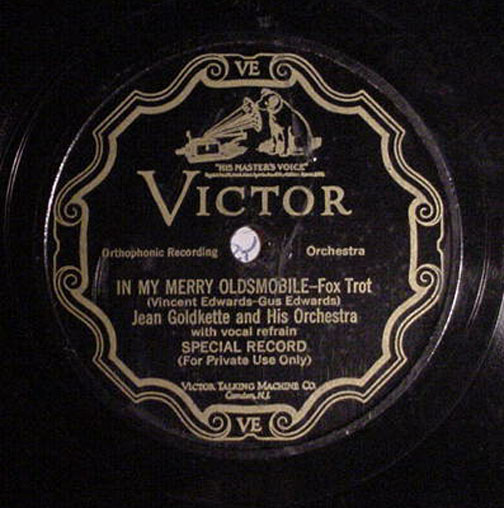 i
i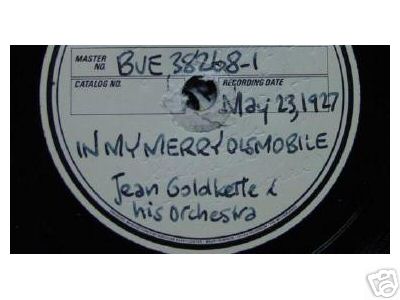
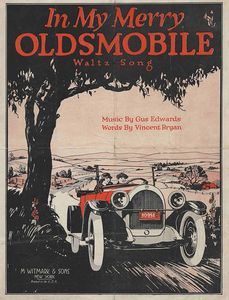


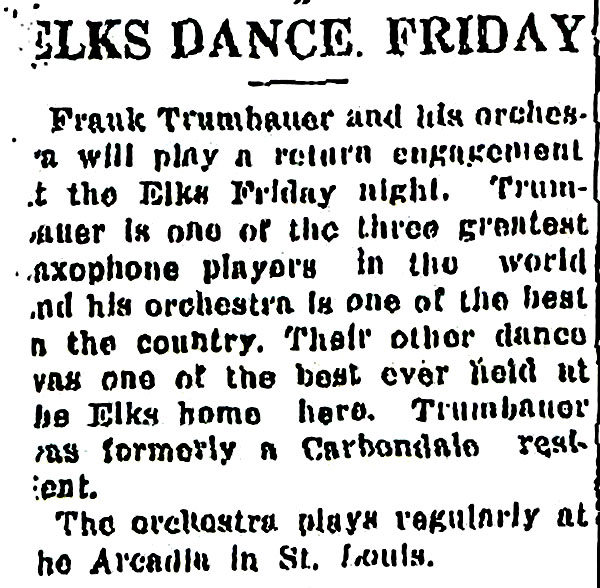

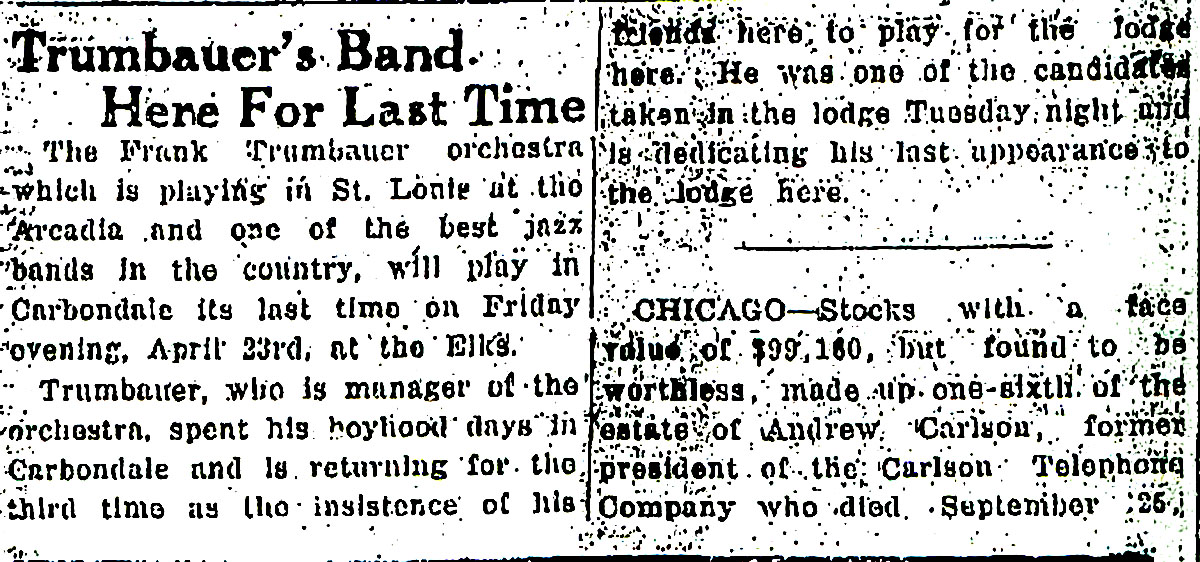

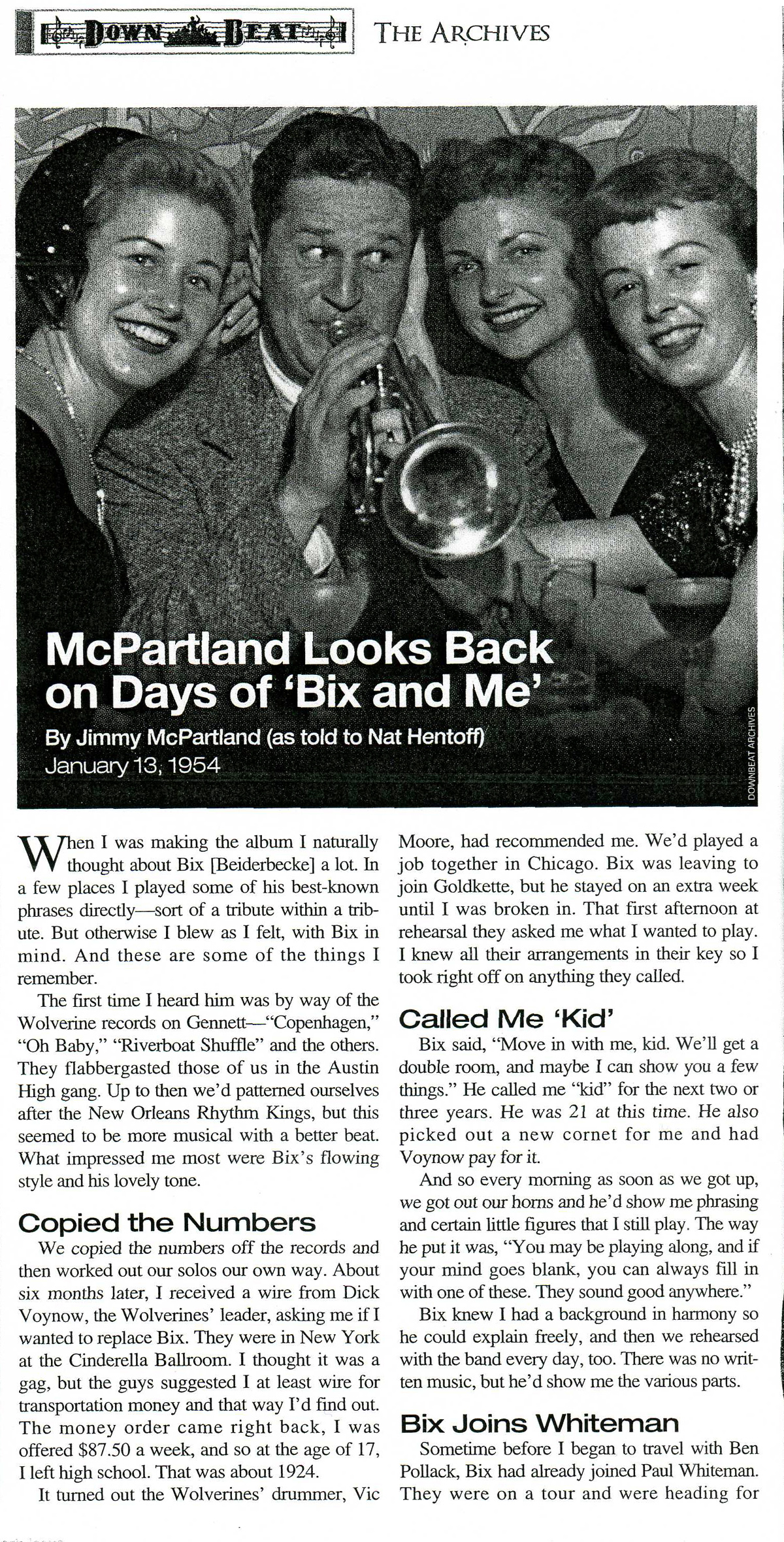
Bix And Benny IAJRC Journal, vol 42,
No. 3,
Sep 2009
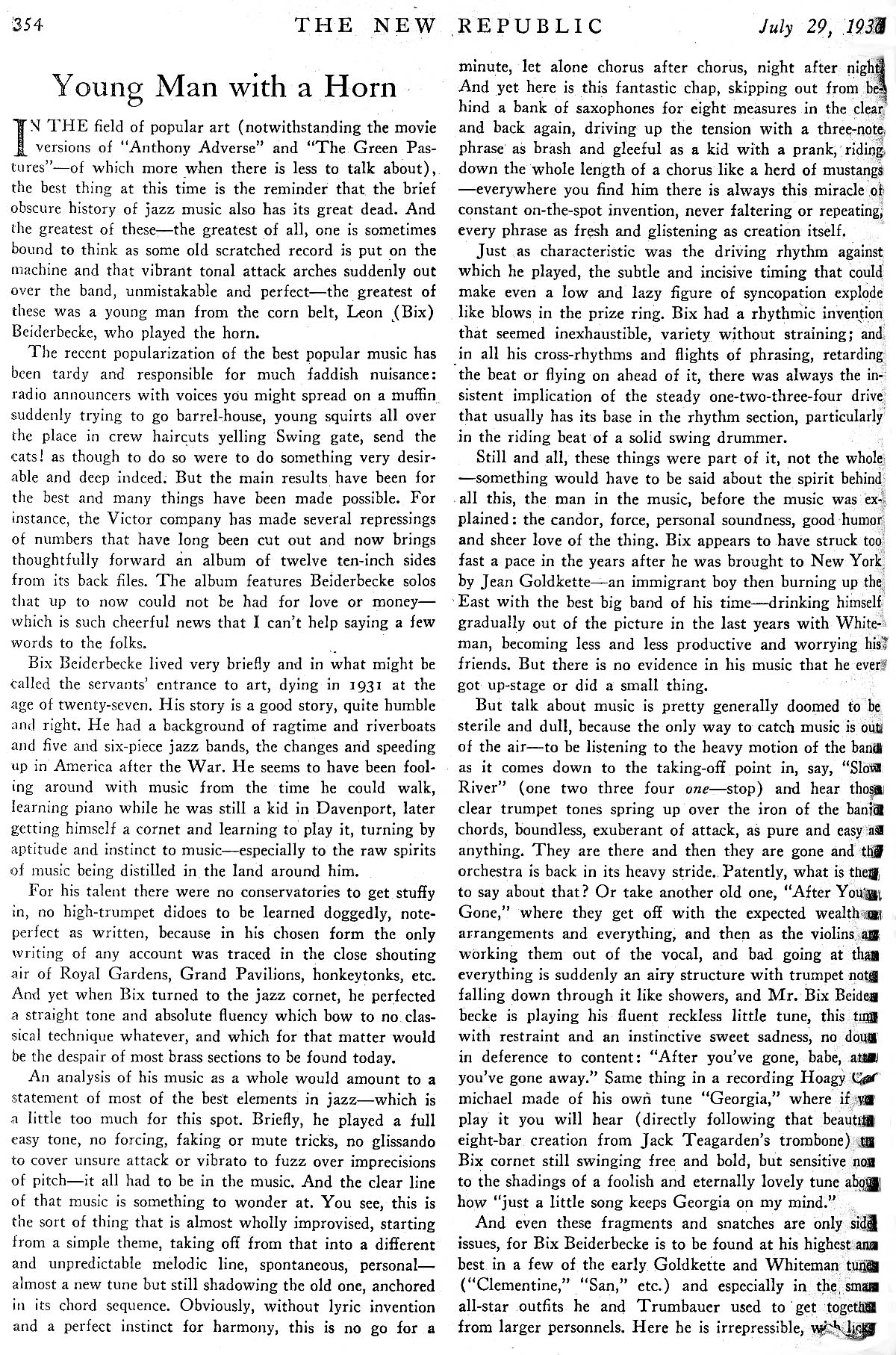
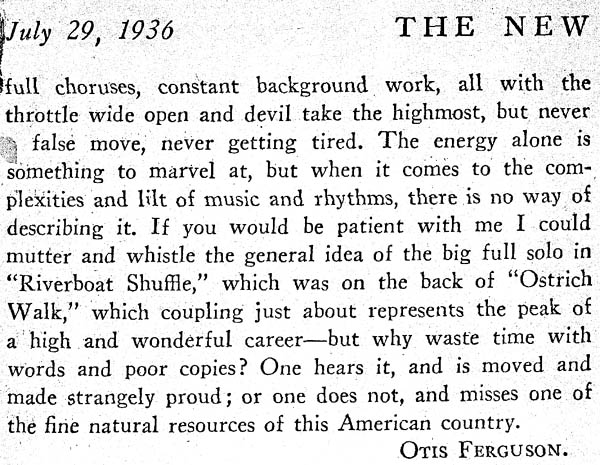
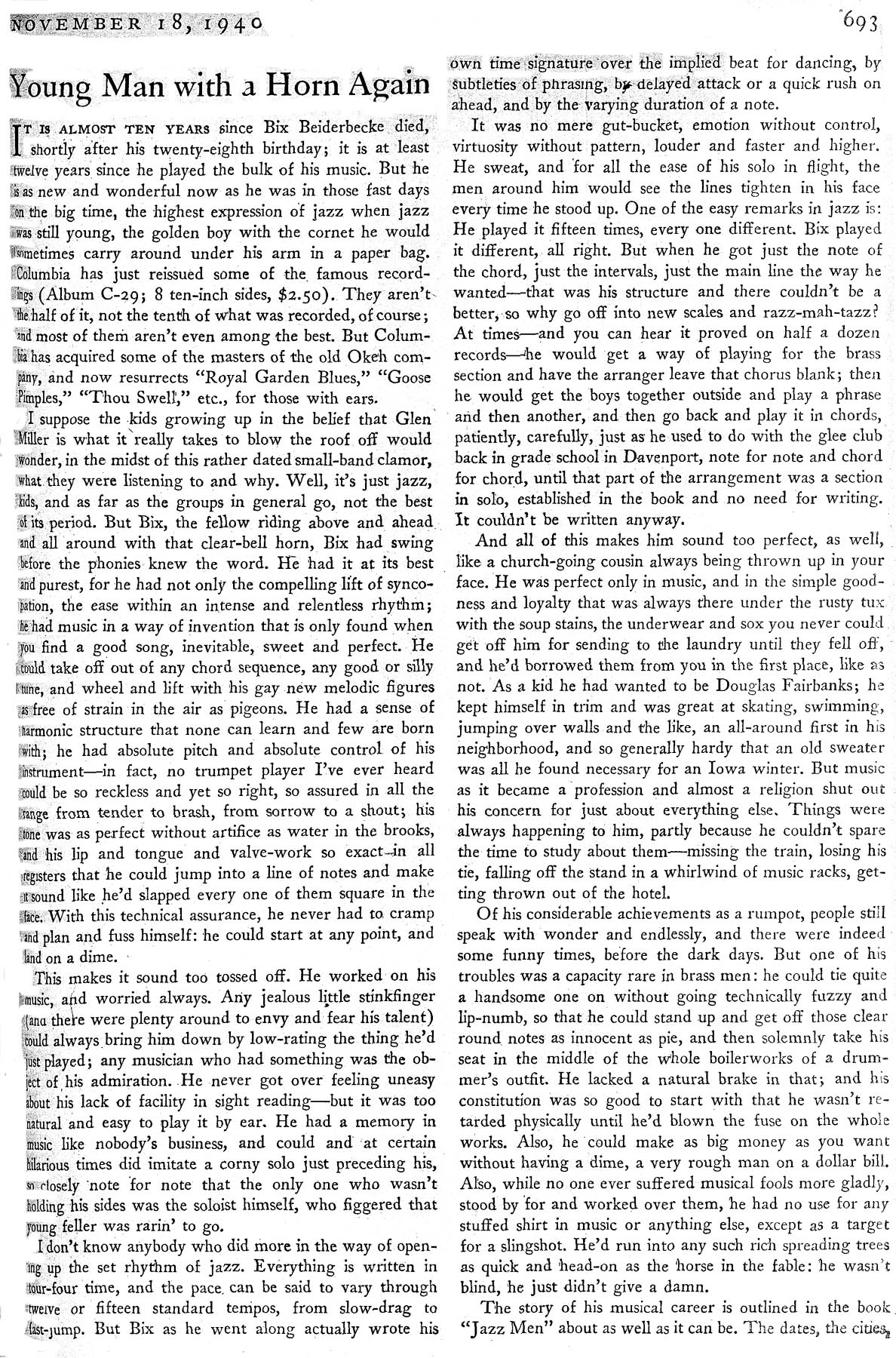
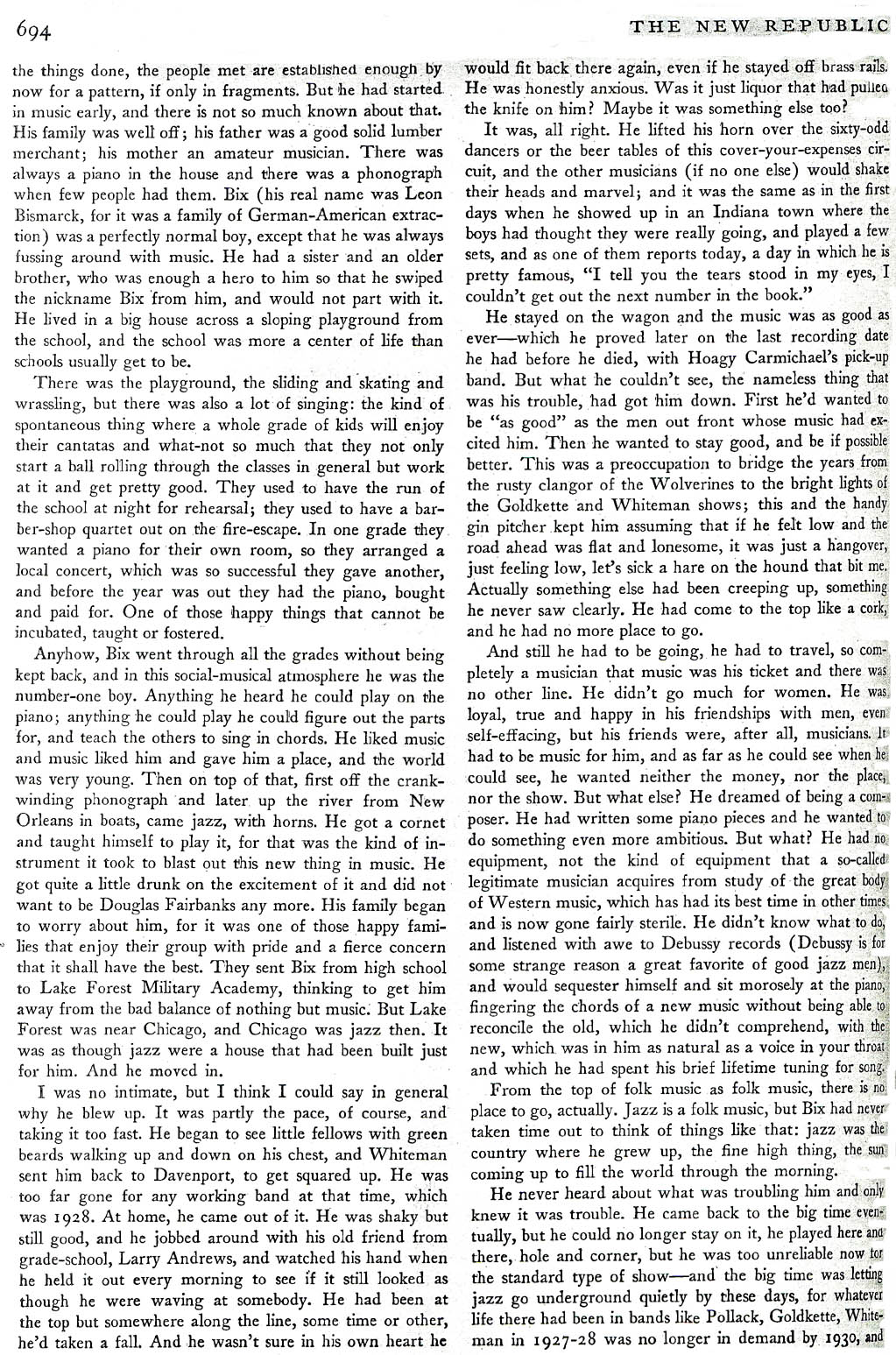

Bix Beiderbecke: His Influences and Playing Style While with the Wolverines. Uploaded Oct 1, 2009.
Melody Maker Review of "Sweet Sue." Uploaded Oct 3, 2009.
http://bixbeiderbecke.com/SweetSue/MMReviewSweetSue.html
Uploaded
Nov 1, 2009.
Don Murray - The
Early Years (1904-1923) by Warren K. Plath. Uploaded Nov 1, 2009.
Published
in Storyville 122, December 1985-January 1986.
http://bixbeiderbecke.com/DonMurray/DonMurrayStoryville.html
I
thank Nick Dellow for his generosity; he scanned the article, sent the
images, and gave me permission to upoad here.



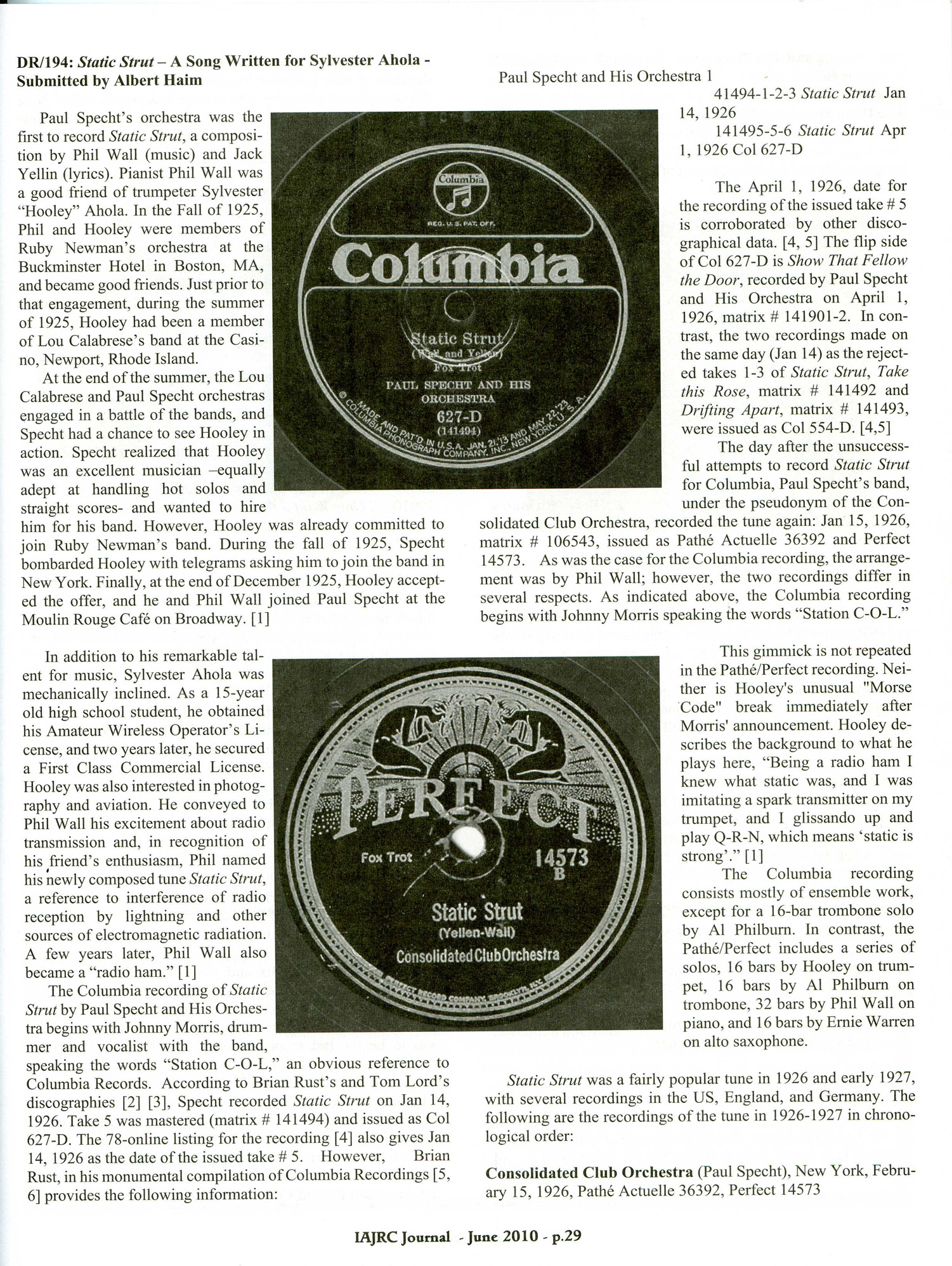

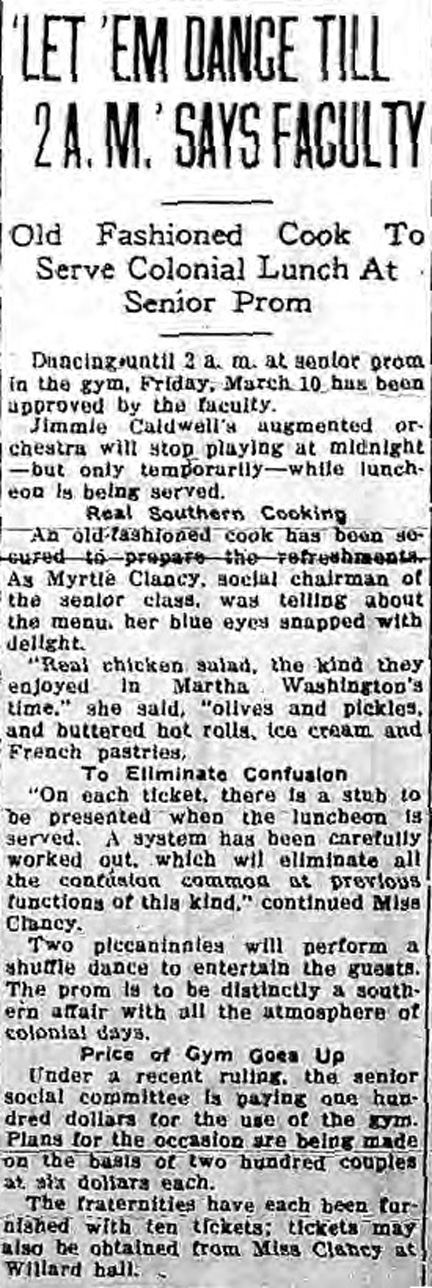

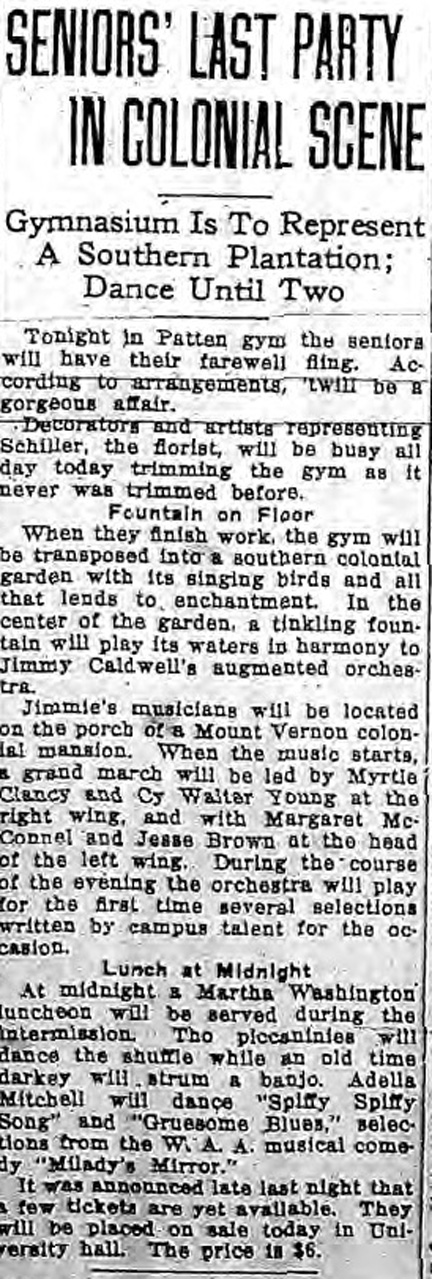


A Conversation
With Charles Margulis. (Uploaded
Dec 15, 2010) Hear Me Talkin' to YO
Link http://bixography.com/MargulisHolbrook/A
Conversation With Charles Margulis.html
"Hear
Me Talkin' to Ya: The Story of Jazz Told by the Man Who Made It"
by Nat Shapiro and Nat Hentoff consists of interviews of jazz
musicians telling their stories in their own words. The following are
links to the pages in the chapter about Bix Beiderbecke and the pieced
together statements throughout the book by Pee Wee Russell and Jimmy
McPartland.
Nick Dellow scanned the relevant pages of the book and put together the
comments by Pee Wee Russell and Jimmy McPartland. I am grateful to Nick
for his generosity in sharing the scans with the Bixography audience.
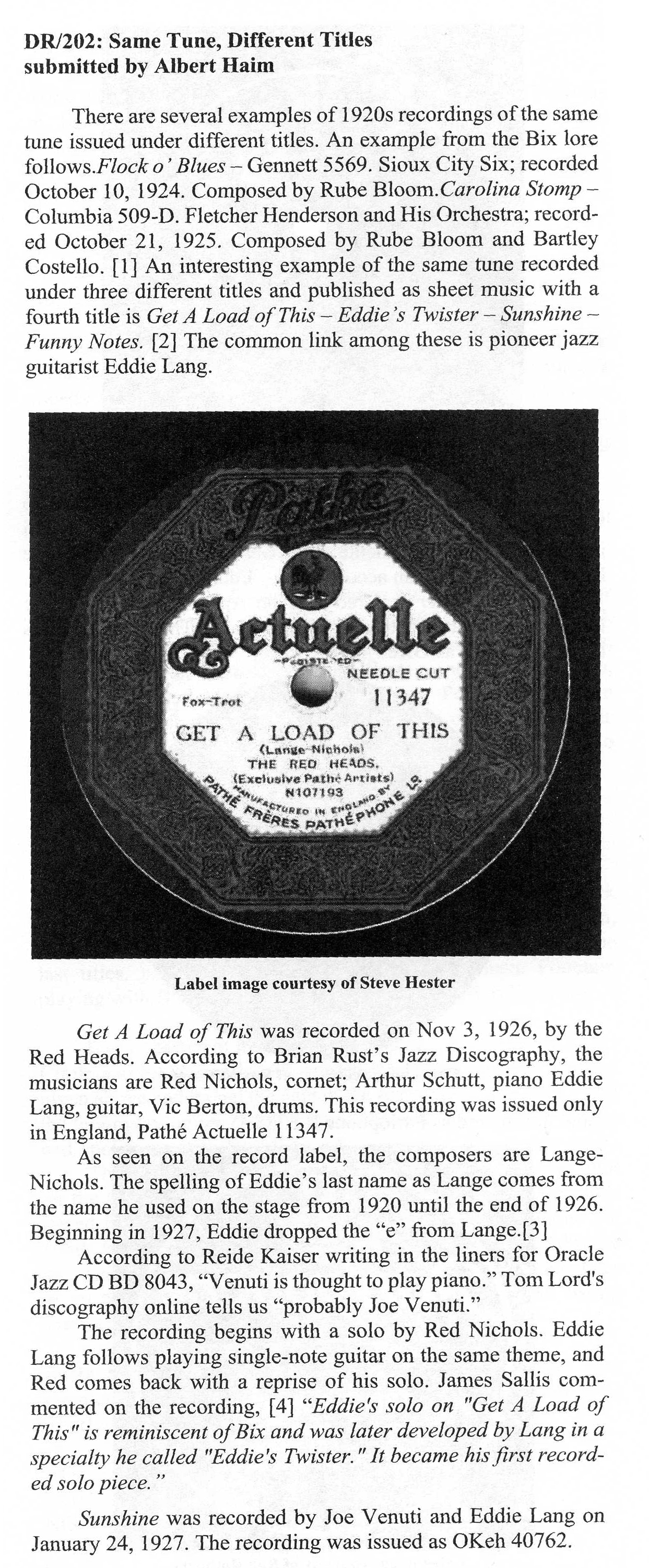
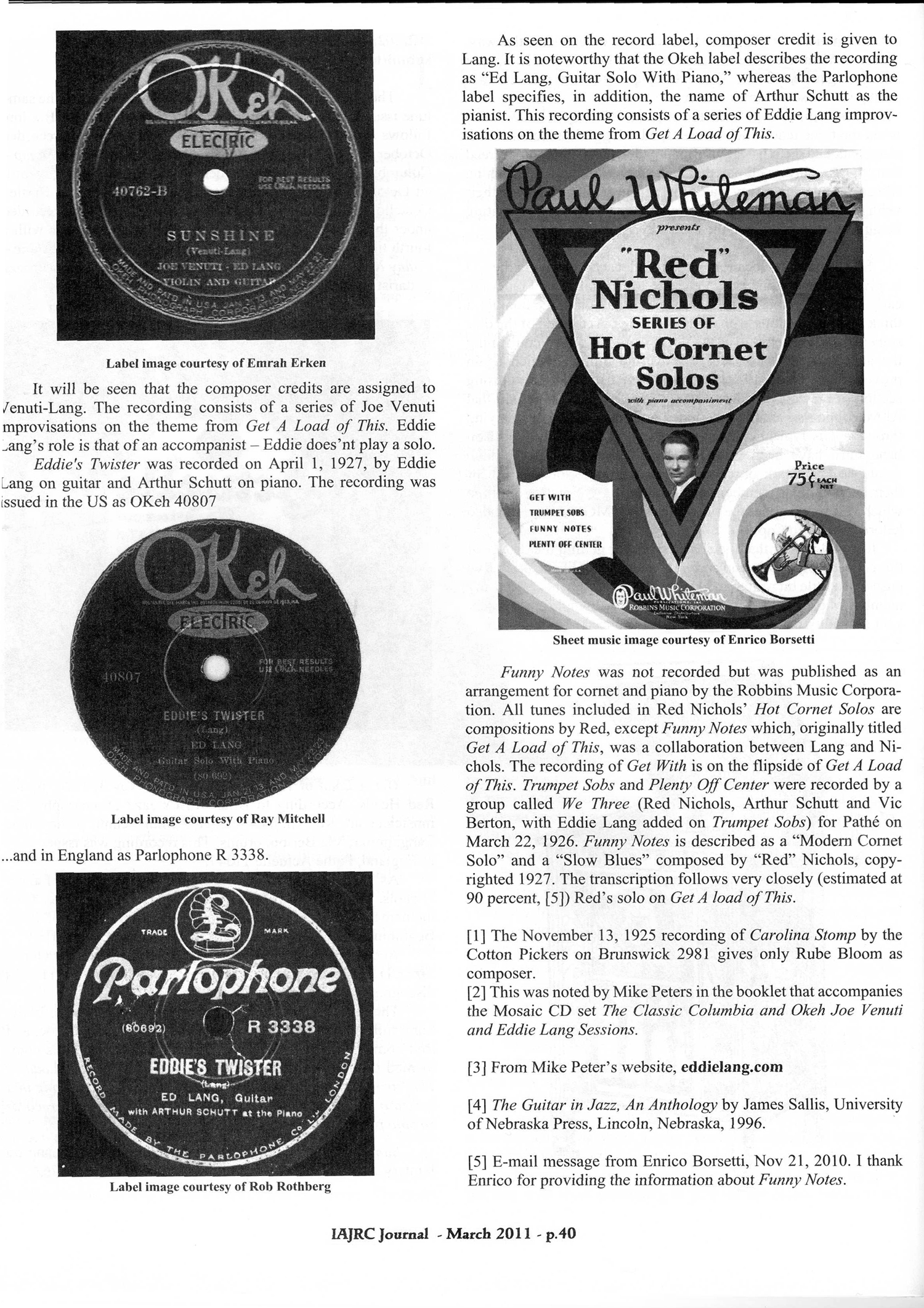

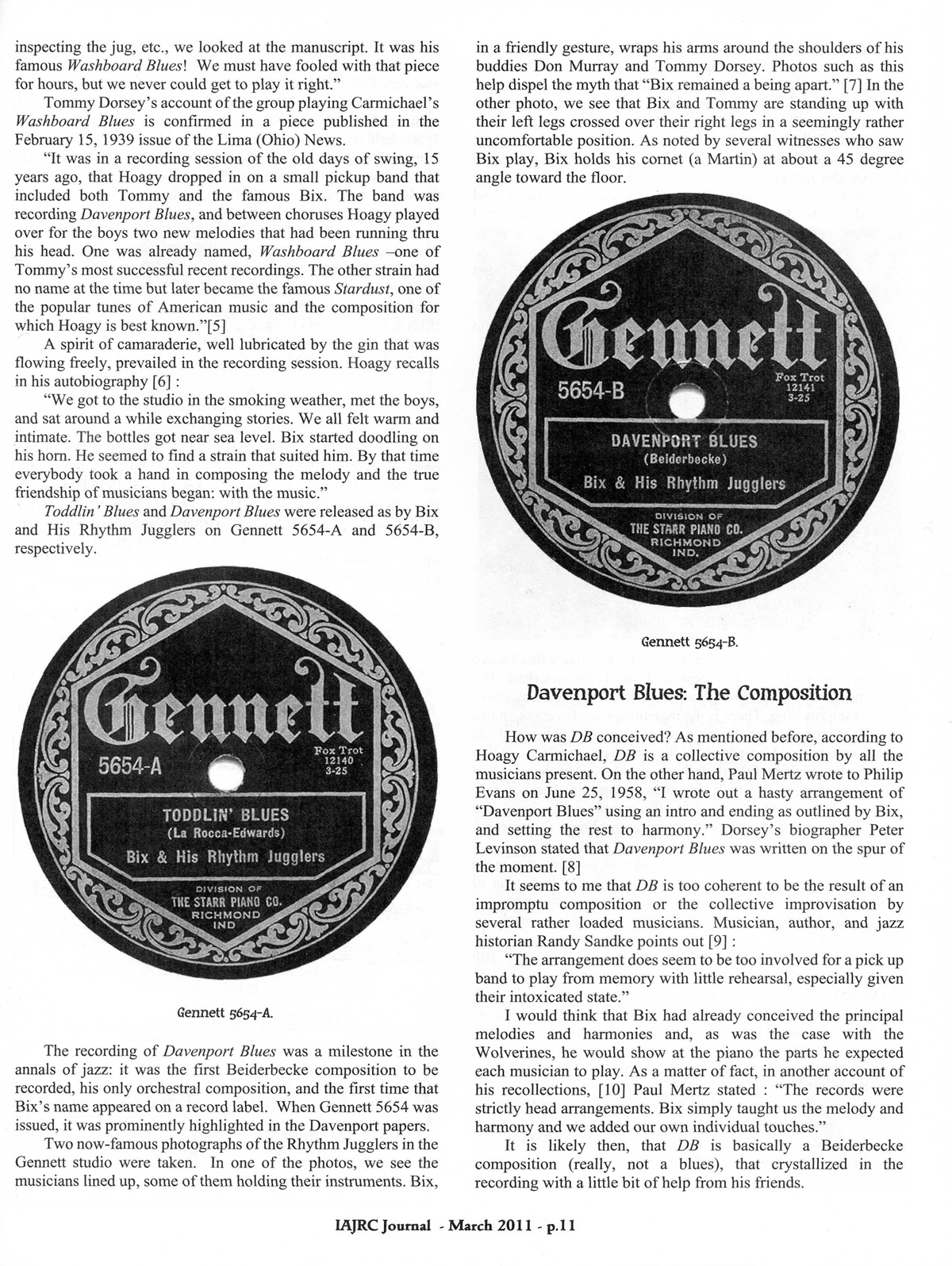
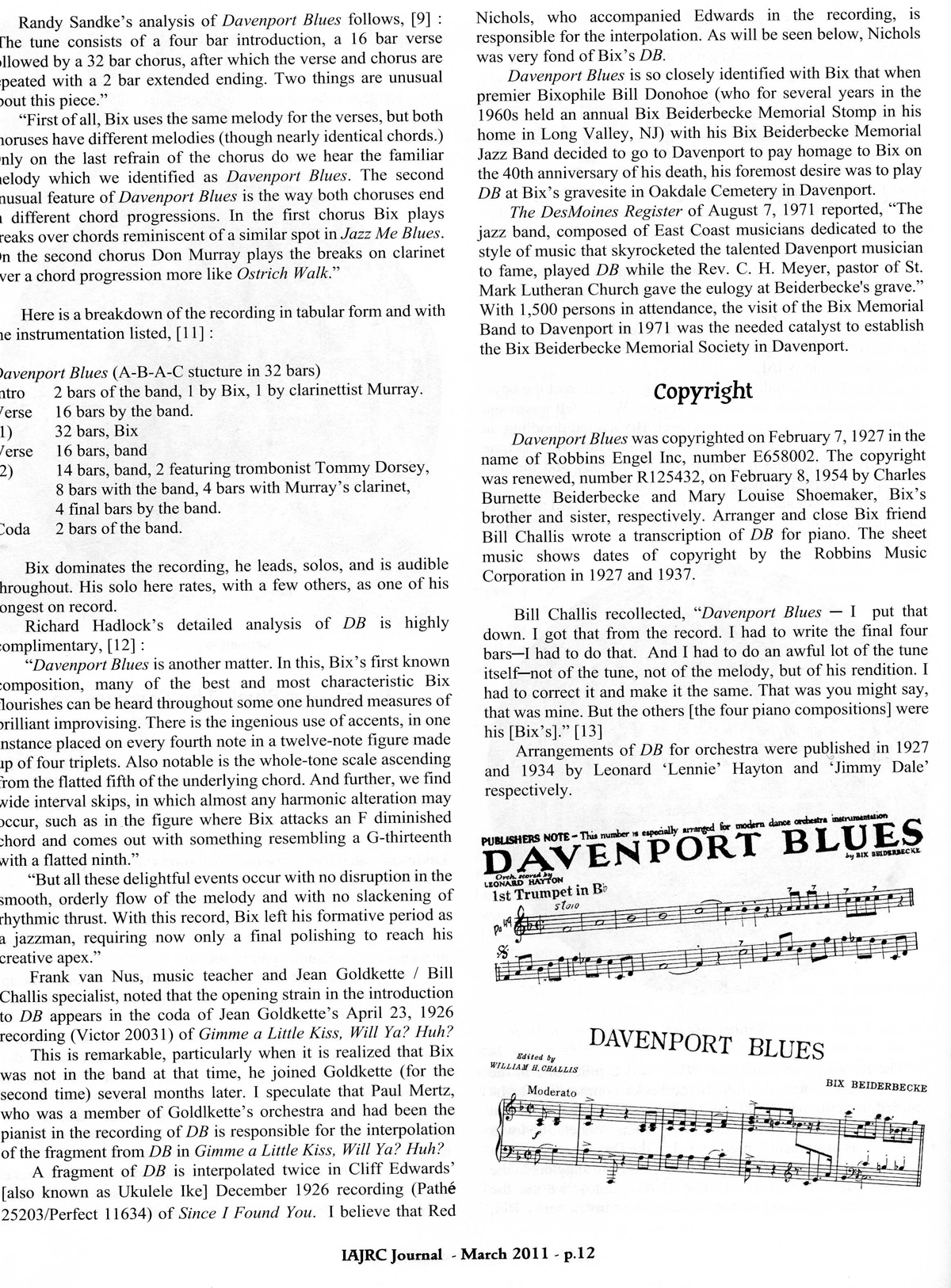
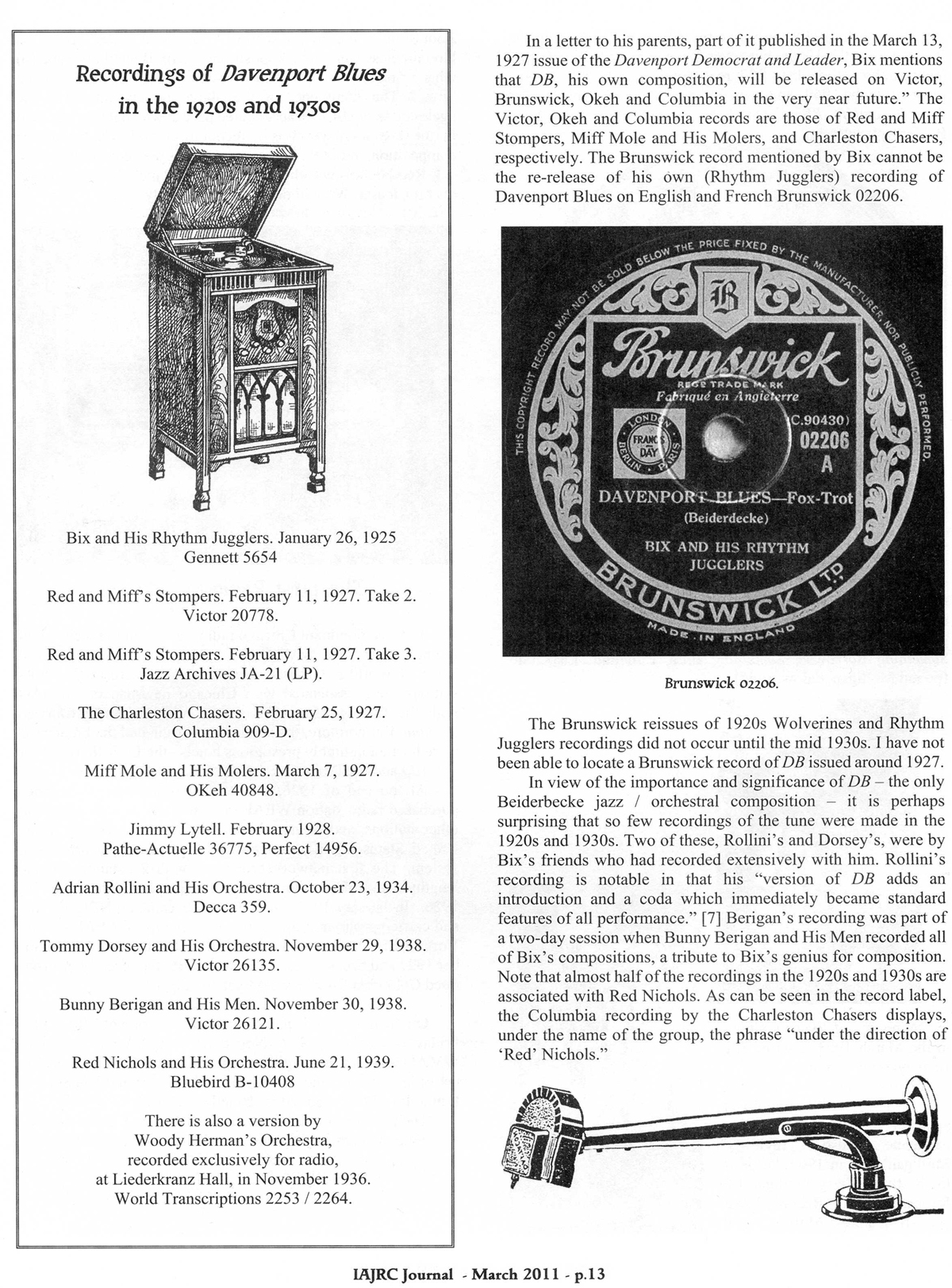
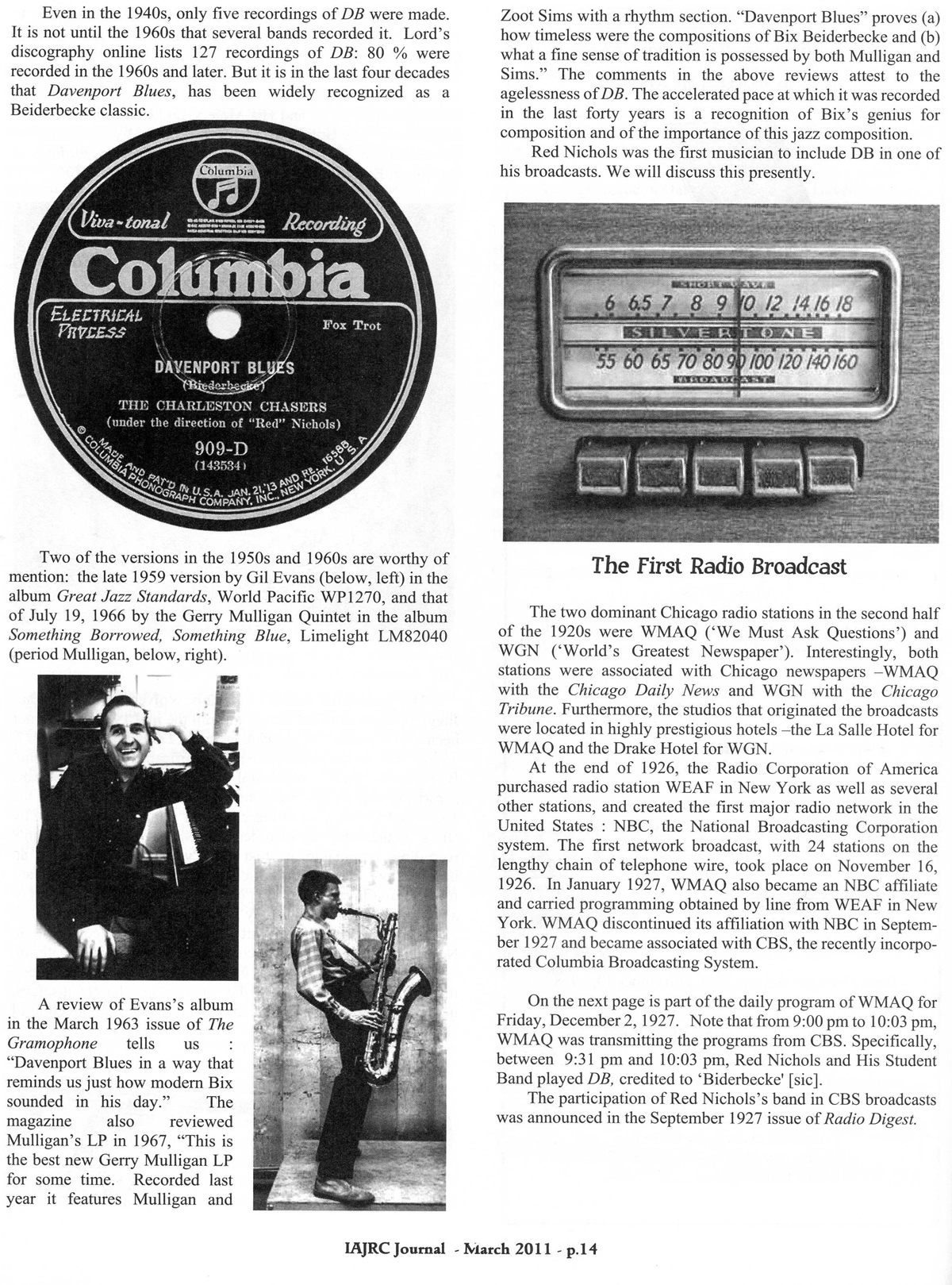

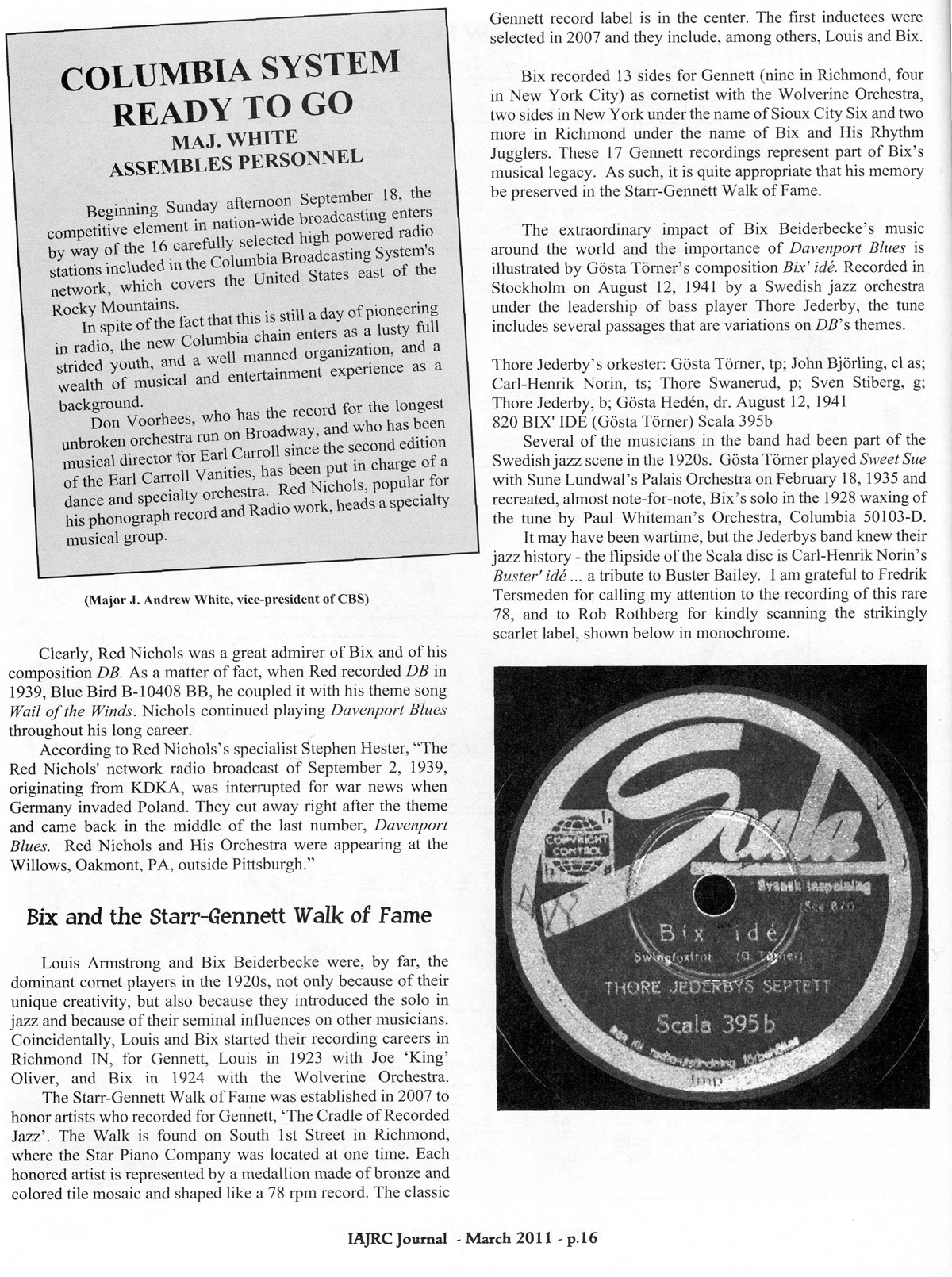

BRIEF TABLE OF CONTENTS
Recordings
The
Original 78's
Analysis
of Some Recordings: Is It Bix or Not ?
Complete
Compilations of Bix's Recordings
Tributes
to Bix
Miscellaneous
Recordings Related to Bix
In
A Mist